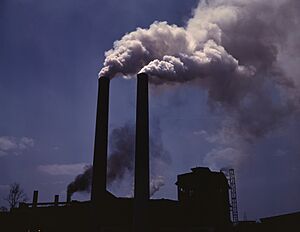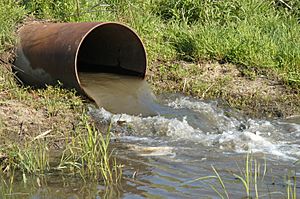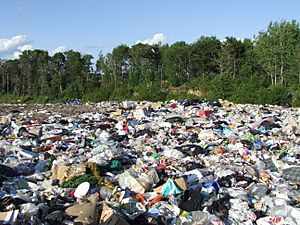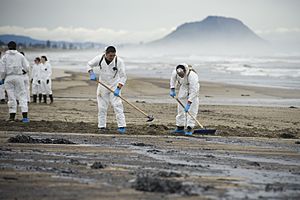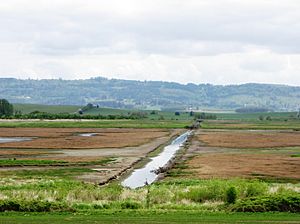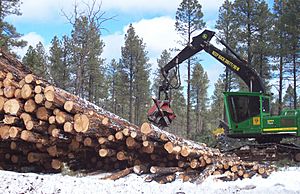Environmental law facts for kids
Environmental laws are rules and regulations designed to protect our planet and its natural resources. They help manage how human activities affect things like forests, minerals, and water. These laws deal with important issues such as stopping pollution, saving resources, protecting different kinds of plants and animals, and fighting climate change.
Environmental laws became very important in the middle of the 20th century. People started to notice how much pollution and damage was happening to the environment. This led to big international meetings, like the Stockholm Conference in 1972 and the Rio Declaration in 1992. Key ideas in these laws include the "precautionary principle," which means taking action to prevent harm even if there's some uncertainty, and the "polluter pays principle," which means those who cause pollution should pay to clean it up.
Around the world, agreements like the Paris Agreement (2015) and the Convention on Biological Diversity (1992) help countries work together on environmental problems. Many countries also have their own laws, like the UK's Clean Air Act of 1956, which helps control air pollution.
Contents
History of Environmental Laws
People have always had some rules to protect nature, but modern environmental laws really started to grow when pollution became a huge problem.
For example, in London in 1858, the River Thames smelled so bad because of sewage that it was called the "Great Stink." This made the government build a new London sewerage system to clean up the river.
Later, in 1952, London had a terrible "Great Smog" caused by burning coal. This led to the Clean Air Act 1956. This law set limits on pollution from homes and businesses to make the air safer to breathe.
Controlling Pollution
Environmental laws work to control different types of pollution to keep our planet healthy.
Clean Air
Air quality laws help make sure the air we breathe is safe. They measure things like nitrogen dioxide and carbon monoxide in the air. High levels of these pollutants can be bad for our health over time. These laws set limits on how much pollution can be released into the air by factories and cars.
Clean Water
Water quality laws protect our rivers, lakes, and oceans. They aim to keep water clean and safe for drinking, swimming, and for animals that live in the water. These laws stop harmful substances from being dumped into water sources.
Managing Waste
Waste management laws help us deal with the trash we create. They encourage us to reduce, reuse, and recycle. This helps save energy and natural resources. These laws also make sure that landfills are operated safely to prevent pollution.
Cleaning Up Contaminants
Environmental cleanup laws deal with pollution that has already happened, like oil spills or contaminated land. They make sure that harmful substances are removed or treated. For example, sewage treatment plants filter out contaminants to keep our water clean.
Chemical Safety
Chemical safety laws control how chemicals are used, especially in factories and products. These laws try to prevent harmful chemicals from getting into our environment or affecting our health. They might ban certain chemicals in products or regulate how pesticides are used. For instance, the Toxic Substances Control Act of 1976 in the US helps decide which chemicals are safe.
Protecting Resources
Checking Environmental Impact
Environmental impact assessment is a process where people check what effect a new project, like building a road or a factory, might have on the environment. This helps make sure that big projects don't cause too much harm to nature.
Water Resources
Water resource laws manage how we use water. They ensure that everyone has access to clean, safe, and affordable water. These laws also work to prevent water pollution and make sure water is used wisely, especially during droughts.
Mineral Resources
Mining laws help manage how minerals like gold or iron are taken from the ground. These laws try to make sure mining is done safely for workers and doesn't cause too much damage to the environment, like polluting water. They also aim to ensure that the source of minerals is known and responsible.
Forest Resources
Forestry laws protect our forests. They help manage how trees are cut down and replanted. These laws are important for keeping forests healthy, which provides homes for animals and helps clean our air.
Wildlife and Plants
Wildlife laws protect wild animals and plants. They stop people from harming or killing protected species and help save their habitats. These laws also fight against illegal wildlife trade, which is a big problem around the world. Organizations like Interpol and Europol work to stop these crimes.
Fish and Game
Fish and game laws control hunting and fishing. They set rules about when, where, and how many animals can be caught or hunted. These laws help make sure that fish and animal populations stay healthy and don't get overfished or overhunted. They also help fund conservation efforts.
Illegal fishing is a major issue that can harm ocean ecosystems and reduce fish populations. Laws try to prevent this to protect marine life and ensure there's enough fish for everyone.
Main Ideas in Environmental Law
Environmental law has some core ideas that guide how it works.
Sustainable Development
This idea means meeting our needs today without making it harder for future generations to meet their own needs. It's about balancing economic growth with protecting the environment. Laws that require checking environmental impact before development are based on this idea.
Fairness (Equity)
Fairness in environmental law means that everyone, now and in the future, should have fair access to Earth's natural resources. It also means that the current generation should think about how their actions affect the environment for future generations.
Responsibility Across Borders
This principle means that countries have a duty to protect their own environment and prevent harm to neighboring countries. For example, if pollution from one country crosses into another, the first country has a responsibility to deal with it.
Public Involvement and Openness
These principles mean that governments and companies should be open about their environmental plans and allow people to have a say. This includes giving people access to information about environmental issues and allowing them to participate in decisions.
Precautionary Principle
This principle says that if there's a threat of serious harm to the environment, we should take action to prevent it, even if we don't have all the scientific proof yet. It's like saying, "better safe than sorry" when it comes to protecting nature.
Prevention
The idea of prevention is about stopping environmental harm before it happens. This can involve setting limits on pollution, requiring special permits for activities that might cause harm, or using the best available technologies to reduce environmental impact.
Polluter Pays Principle
This principle means that whoever causes pollution should pay for the costs of cleaning it up and preventing future harm. It makes sure that companies and individuals are responsible for the environmental damage they create.
Debates About Environmental Law
Environmental laws can sometimes cause disagreements. People debate how much environmental protection is needed, how fair the laws are, and how much they cost.
Some argue that environmental rules are too expensive for businesses. However, many environmentalists believe that a healthy environment is priceless and that the economy depends on it. It can be hard to put a value on things like clean air or healthy ecosystems.
There are also debates about whether current laws are strong enough. Many groups believe we need even stronger protections for the environment.
Environmental Laws Around the World
Environmental issues often cross borders, so countries work together through international agreements.
Africa
Many African countries face challenges like drought, floods, air pollution, and loss of animals and plants. Organizations like the U.S. United States Environmental Protection Agency (EPA) work with African nations to help strengthen their environmental laws and improve public awareness.
Asia
The Asian Environmental Compliance and Enforcement Network (AECEN) is a group of 16 Asian countries that work together to improve environmental laws and their enforcement across the continent.
European Union
The European Union (EU) has many environmental laws that apply to its member countries. These laws cover topics like climate change, air pollution, water protection, waste management, and protecting nature. For example, the EU has laws to protect important natural areas and species. In February 2024, the European Parliament made serious environmental damage a crime punishable by up to 10 years in prison.
Middle East
Environmental law is growing in the Middle East. The U.S. United States Environmental Protection Agency works with countries there to improve environmental management, water quality, and pollution prevention.
Oceania
In Oceania, concerns include illegal pollution, illegal logging, and the shipment of hazardous waste. The Secretariat of the Pacific Regional Environmental Programme (SPREP) helps countries in this region protect their environment and develop sustainably.
Australia
Australia's main environmental law is the Environment Protection and Biodiversity Conservation Act 1999. This law protects important plants, animals, and heritage sites. However, some reviews have suggested that these laws need to be stronger to protect Australia's unique species.
Brazil
Brazil created the Ministry of Environment in 1992 to develop strategies for protecting nature and using natural resources wisely, especially in the Amazon.
Canada
Canada has its own Department of the Environment and laws like the Canadian Environmental Protection Act, 1999. These laws focus on preventing pollution and protecting human health and the environment.
China
China has been working hard to develop and enforce environmental laws due to rapid economic growth causing significant environmental problems. They are trying to balance development with protecting the environment.
Ecuador
In 2008, Ecuador became the first country to include the Rights of Nature in its constitution. This means that ecosystems have legal rights to exist and thrive, and people can act to protect them. This was a big step away from treating nature only as property.
Egypt
Egypt's Environmental Protection Law outlines the government's duties to manage the environment, collect data, and set standards for development.
India
In India, environmental law is mainly governed by the Environment Protection Act of 1986. There are also specific laws for water, air, and wildlife protection. The National Green Tribunal handles many environmental cases.
Japan
Japan's Basic Environmental Law guides its environmental policies. It focuses on enjoying the environment now and in the future, creating a sustainable society, and contributing to global environmental protection.
New Zealand
New Zealand's Ministry for the Environment advises on environmental laws. The main law is the Resource Management Act 1991, which manages how land, water, and other resources are used.
Russia
Russia's Ministry of Natural Resources and Environment is responsible for protecting natural resources, including forests, water, animals, and their habitats.
Singapore
Singapore has laws to protect its biodiversity and control trade in endangered animals. The Wildlife (Protected Wildlife Species) Rules 2020 directly protect specific animal species.
United States
The United States has many environmental laws, including the Clean Air Act, Clean Water Act, and the Endangered Species Act. These laws are enforced by agencies like the Environmental Protection Agency (EPA).
Vietnam
Vietnam is working with the U.S. Environmental Protection Agency to reduce pollution from chemicals like dioxin and lower methane emissions.
See also
 In Spanish: Derecho ambiental para niños
In Spanish: Derecho ambiental para niños
- Climate target
- Energy law
- Environmental health
- Environmental justice
- International law
- List of international environmental agreements


